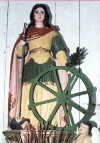Saint Catherine was a royal,
learned; rich and virgin gloriously martyred at Alexandria whose festival falls on
November 25. Chosen as the patroness and models of Christian philosophers, Aecatherina, as
she called by the Greeks, glorified God by an illustrious confession of the faith of
Christ under MaximinusII.
Emperor Basil, in his Greek Menology, related that St. Catherine, an excellent scholar belonging to the royal blood, confuted a company off ablest heathen
philosophers whom Maximinus commanded to enter into a disputation with her, and that
having been converted to the faith by his saint, they were all burnt in one fire for
confession the same.
an excellent scholar belonging to the royal blood, confuted a company off ablest heathen
philosophers whom Maximinus commanded to enter into a disputation with her, and that
having been converted to the faith by his saint, they were all burnt in one fire for
confession the same.
According to Emperor Basil, St. Catherine was at length beheaded.
She was put up upon an engine made of four wheels joined together and stuck with sharp
pointed spikes, that when the wheels were moved, her body might be lacerated to pieces. At
the first stirring of the dreadful engine, the cords with which the martyr was tied were
broken as under by the invisible power of an angel. She was delivered from death as the
engine fell to pieces by the wheels, which were separated from one another. Hence the name
of St. Catherine's wheel.
Various legends about St. Catherine existed among which could be
cited the life of a certain woman, a Christian, and the richest and the most noble of all
the ladies of Alexandria, who, when the rest suffered themselves to be deflowered by the
tyrant Maximin, resisted and vanguished his unbounded and then worse beastly lust. This
lady was most illustrious for her high birth and great wealth; and likewise for her
singular learning; but she preferred her virtue and her chastity to all worldly
advantages. The tyrant, having in vain made several assaults upon her virtue, would not
behead her, seeing her ready to die, but striped her of all her estates goods and sent her
to banishment.
It would be said that after man miracles the Christians in Egypt
discovered St. Catherine's body about the 18th century, when they groaned under the yoke
of the Saracens. It was soon after translated to the great monastery on the top of Mt.
Sinai in Arabia, built by St. Helen, and sumptuously enlarged and beautified by the
Emperor Justinian.
Falconius, Archbishop of San Severina, spoke this translation:
" As to what is said, that the body of this saint was conveyed by the angels to Mt.
Sinai, the meaning is that it was carried by the monks of Sinai to their monastery, that
they might devoutly enrich their dwelling with such a treasure. It is well known that the
name of an angelic habit was often used for a monastic habit, and that monks, on account
of their heavenly purity and functions, were anciently called "angels".
St. Paul of Latra kept her feast, the 25th November, with
extraordinary solemnity and devotion.
As described by Dr. Richard Peacock, the principal part of the
mortal remains of St. Catherine is still kept in a marble chest in the church of the
monastery in Mt. Sinai.
St. Catherine's prayer before her death, "the conversion of the
world to Christianity," was granted for when Constantine defeated Numantinus, the
world became Christian.